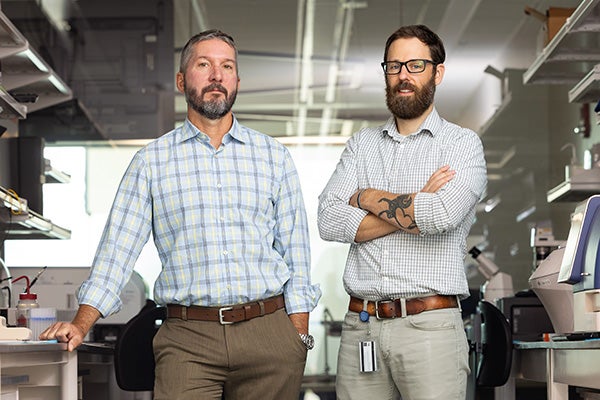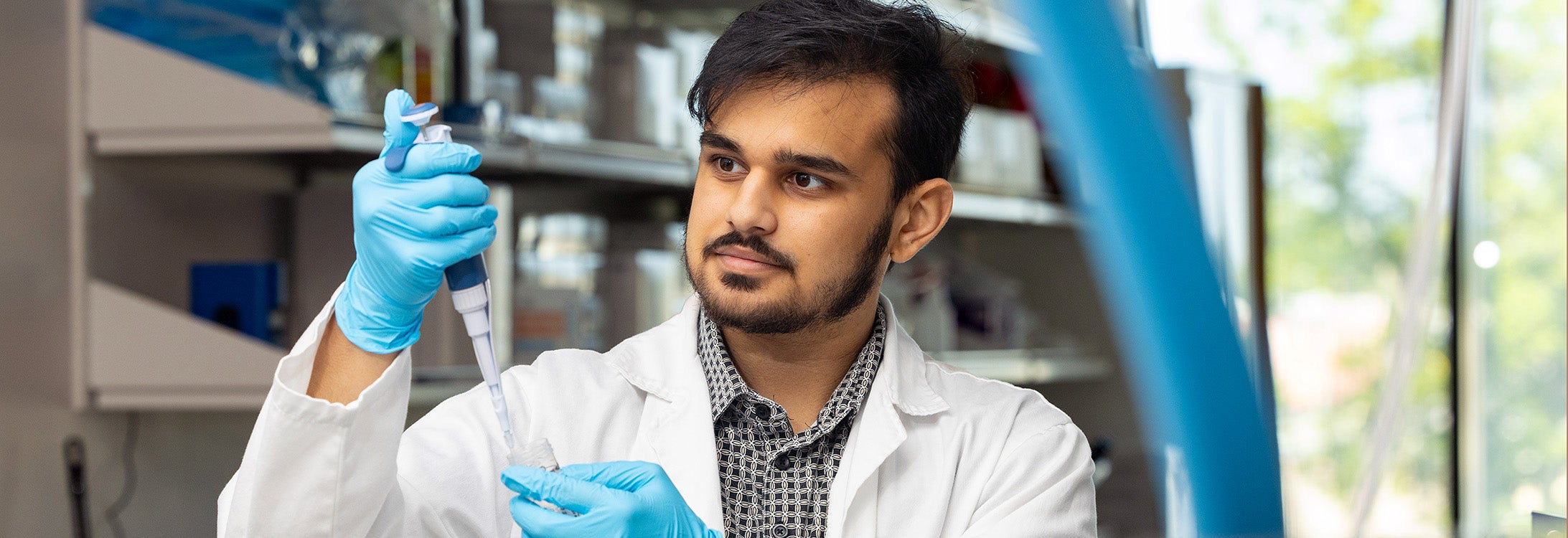FERTILITY RESEARCH
Grant funds innovative ECU research into fertility challenges
East Carolina University research scientists, two from the Brody School of Medicine and another from the Department of Biology in the Thomas Harriot College of Arts and Sciences, received nearly $2 million in funding from the National Institutes of Health (NIH) to find better ways to help people dealing with infertility get the best chance at welcoming healthy children into their families.
Unlocking the secrets of fertility is a daunting task, the researchers agree, but if they are successful they may be able to help reduce the often prohibitive cost of assisted reproductive therapies (ART) like invitro fertilization (IVF) or pioneer new forms of contraception, ones free of the health risks associated with current female hormone-based birth control methods.
For years Dr. Chris Geyer, a Brody associate professor of anatomy and cell biology, has studied how spermatogenesis, the development of male reproductive cells, works. He has worked closely with Dr. Darrell Neufer, a Brody professor of physiology and an expert in cellular metabolism.

Dr. Chris Geyer, left, a Brody School of Medicine associate professor of anatomy and cell biology, and Dr. Cameron Schmidt, an ECU assistant professor of biology, are working on fertility research at ECU.
Geyer’s partner in the NIH study, Dr. Cameron Schmidt, assistant professor of biology, is an expert at understanding how cells use energy and resources from their environments to thrive. Dr. Benjamin Hale, a postdoctoral scholar who works in Geyer’s lab, began working on experiments with Schmidt in 2021.
As a team, Schmidt and Hale made rapid progress, and within months had generated enough preliminary data to apply for internal grant funding from ECU’s Office of Research and Economic Development (REDE) and the Brody Brothers Endowment.
Muscles are routinely used to research metabolism because muscles use energy when contracting. Geyer suggested that Schmidt and Hale might consider using animal sperm cells as an alternative to skeletal muscles because sperm expend energy through swimming and are much easier to isolate than skeletal muscle tissue.
With a team assembled and the NIH grant funding, the two labs have partnered to unlock the secrets of how female and male reproductive systems naturally find the best candidate cells for fertilization.
Fertility by the numbers
Fertility is all about the numbers. Of the nearly 3.7 million babies born in the U.S. in 2022, fewer than 80,000 of those occurred as a result of assisted reproductive therapies like IVF. A 2023 report by the American Society of Reproductive Medicine claimed that ART cycles, the stimulation of a woman’s body to overproduce eggs that are extracted for artificial insemination, had increased 44% in the previous six years, a sign that people who have difficulties getting pregnant really want to have babies.
In humans, of about 100 million sperm released by the male partner, only 100 to 200 make it to the egg. If the male partner can transmit only 10 million, the odds that fertilization will happen naturally go way down, Geyer said.
“A lot has to go right for a sperm to get to the egg,” Schmidt said.
Current treatments
Current IVF treatments involve inducing the female partner to overproduce eggs, surgically harvesting those eggs, and then using a process called intracytoplasmic sperm injection (ICSI). With ICSI, a technician selects an individual sperm with a very tiny needle and then physically inserts the sperm into the egg.
“Clinics are increasingly using ICSI because it increases the possibility of fertilization by bypassing requirements including normal motility and sperm-egg interactions,” Geyer said.
In assisted reproductive therapies, finding a sperm cell for implantation is fairly easy — each sample offers tens, if not hundreds, of millions from which to choose. But finding the best candidate is a matter of determining quality, which is currently nearly impossible. Schmidt equates the process to giving all 350 million Americans a test to find out who would be the one best choice to fill a vacant actuary job.
“If you were to randomly select someone from the American population, the odds of identifying that best person are quite low. If you were to choose a more common task, for example driving, maybe 40% of people can drive a car,” Schmidt said. “So then your odds of being able to select a better candidate is much higher because the candidates have proven their skill at the necessary task.”
Not all sperm are competent to fertilize an egg, which is the point of the team’s study, to figure out how to mimic nature’s process for winnowing hundreds of millions of candidates down to the best sperm capable of generating a healthy offspring.
Geyer believes that male and female bodies team up to select the best candidate sperm for fertilization: the male produces tens of millions of sperm cells but only a handful are actually viable, and the female reproductive tract seems to erect physical and hormonal barriers to permit only the best sperm capable of generating a healthy offspring.
“If I ran the Boston Marathon a million times I would never win. There are probably only 10 men or women who have a real chance to win that marathon. We don’t know if that’s the case with sperm, that only a few hundred are just the best,” Geyer said. “We think that there’s a selection process in the female reproductive tract that allows only the best sperm to reach and fertilize the egg.”
Access to fertility treatment is also a question of cost. The processes used to create viable embryos in a lab are expensive (the national average is around $12,000 for each round) and it’s typically not covered by health insurance. Between 10% and 15% of opposite sex couples are infertile, Geyer said, and most must be willing to pay out of pocket for an opportunity to have a baby.
The team’s thesis
Geyer, Neufer and Schmidt hope to uncover two major implications from their theory about fertilization over the course of their four-year funded study: a way to replicate in a lab setting the physical and chemical obstacles that naturally select the best candidates to fertilize an egg; and the obverse, to identify how these reproductive processes work to design better, safer forms of contraception.
Because the fluid media used for fertilization in IVF treatments are often proprietary, Geyer said his team hopes to develop a useful, and relatively inexpensive, option that would drive down costs for hopeful parents. Also, Geyer sees a possibility of developing a specialized microfluidic device that could help replicate the physical hurdles that sperm must overcome in the female body, which would theoretically help select the best sperm for fertilization.
Sperm are uniquely individual, with their own genomes, which the male body is constantly creating to have a ready supply of hundreds of millions to deposit at a moment’s notice for the fertilization process. The way they use energy, which is what Schmidt studies, can be a big part of which sperm is selected for artificial insemination, but it is ultimately an arbitrary decision.
“Core cellular tests currently used in labs influence which sperm actually ends up fertilizing an egg, and has huge impacts on the downstream process — whether or not fertilization and development even happen,” Schmidt said.
Unlocking some of the secrets of how sperm are able to overcome the Herculean challenges to reach the egg cell might also be useful for finding contraception methods that reduce the current reliance on hormones, which upset the body’s natural rhythms and can pose real dangers to women.
Because there is scant regulatory oversight of fertility science and treatments, unlike the regulation of pharmaceuticals or physical medical devices, Geyer hopes that the team’s rigorous research and rapid implementation of their findings will result in functional results that can benefit hopeful parents in several years rather than decades.
“If we find that our way of selecting sperm increases — maybe doubles or triples the fertilization rates or provides some metric of healthier embryos than what’s being currently used — this could be implemented pretty quickly,” Geyer said.
Geyer is very aware of the moral implications of his work. While their team doesn’t create human embroys for research, that does happen in fertility treatments, and creating embryos that may not be implanted but are frozen for potential use later produces what he considers a “fascinating” ethical quandary that he keeps in mind during his work.
“These are difficult questions. Some groups feel that every embryo is a precious life. But the question is what can be done with them, because there are currently millions of frozen human embryos in cryostorage across the United States and at some point, we’re going to have to make some really difficult decisions,” Geyer said.
Schmidt agrees that while science may be able to find ways of identifying better sperm cell candidates for fertilization, the moral and ethical prohibitions on growing human fetuses for research means that, for the foreseeable future, there will be an enigmatic element in the process.
Geyer, Neufer and Schmidt are committed to reducing the distance between science-based fact and the mystery of how life is created so more families struggling to conceive can replace the stress and financial challenge of fertility treatments with choosing baby names and the color to paint the nursery walls.
